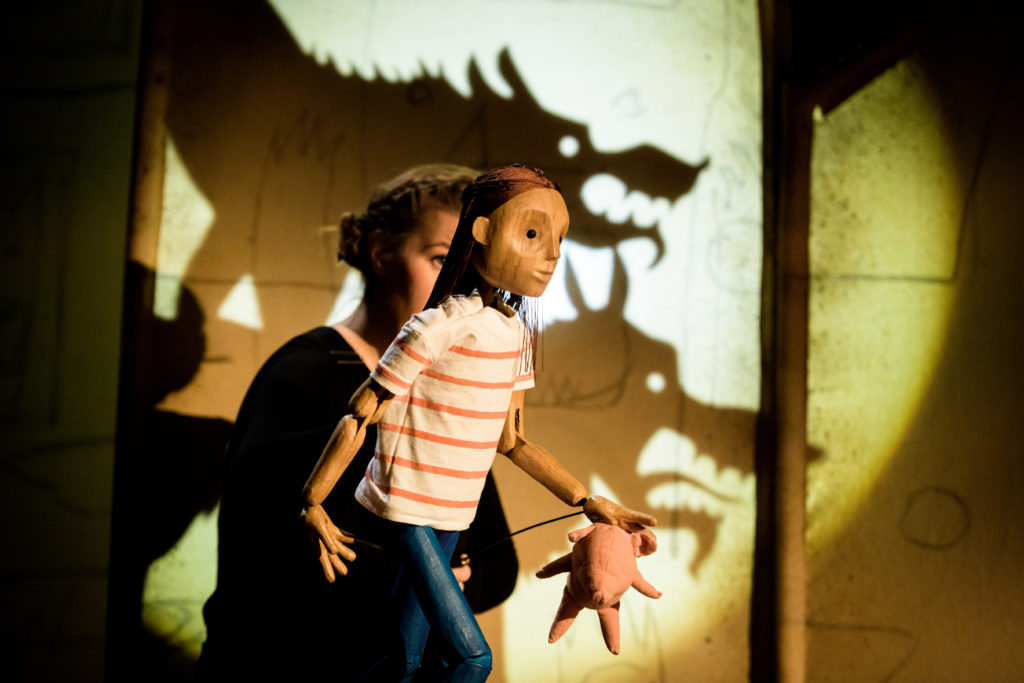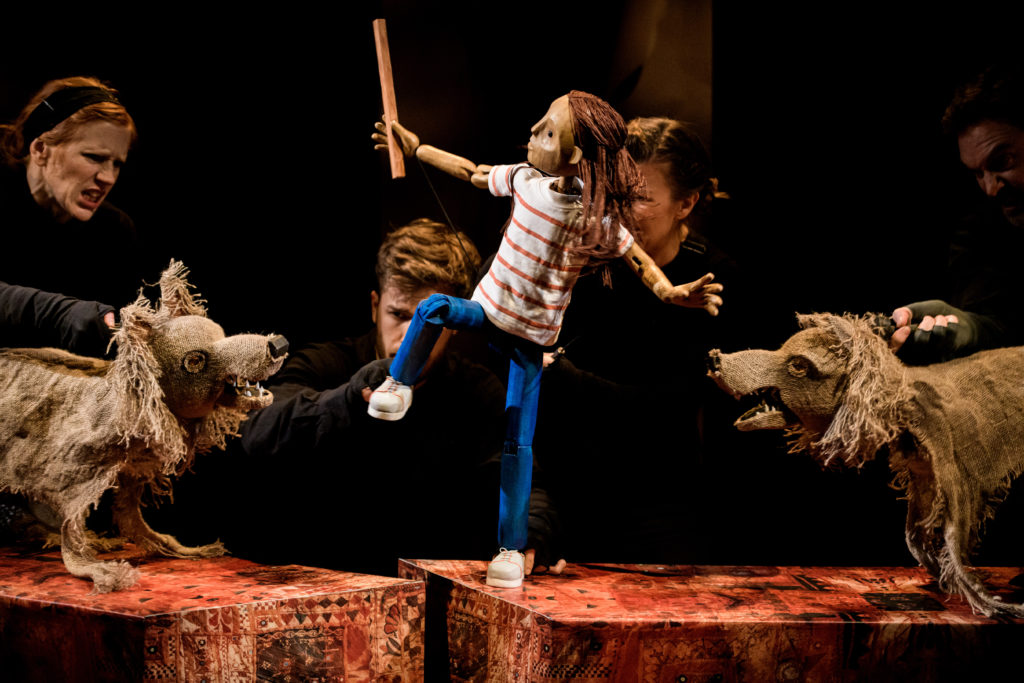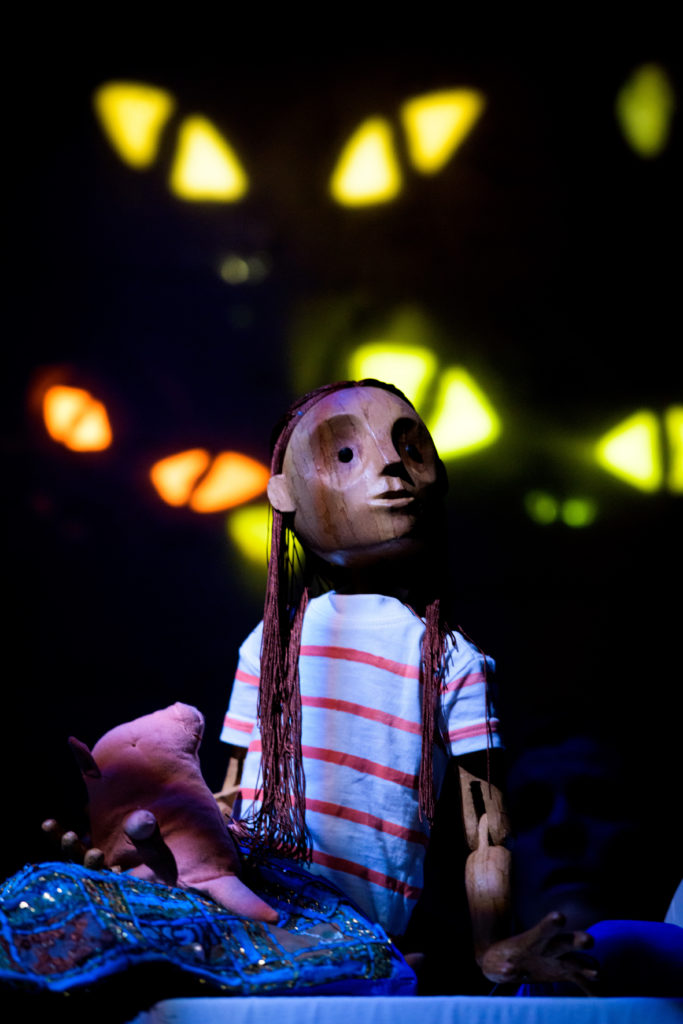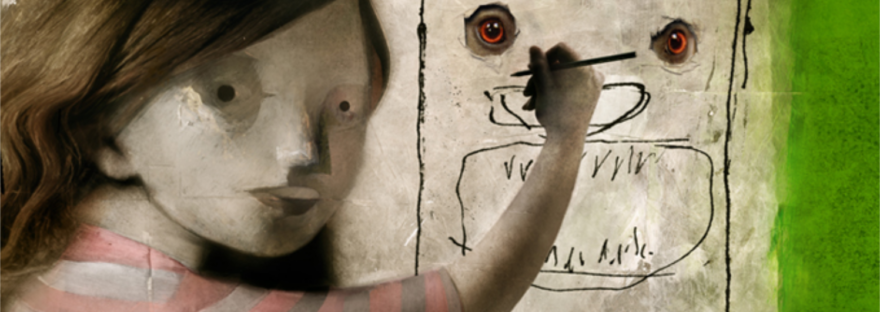“For you know what they say… If the wolves come out of the walls, then it’s all over.”
[Editor note: this article was initially written 3 years ago – we saw the show in March 2020, and then the world ground to a halt, so it didn’t feel appropriate to share it at the time. We were pleased to see it’s back up and running now!]
So Lucy is told in this fantastic stage adaptation by the Little Angel Theatre of Neil Gaiman and Dave McKean’s picture book ‘The Wolves in the Walls’, published back in 2003. Considering how popular Gaiman’s works are, it’s a little surprising that it has taken so long to get a production based on this particular entry – but it was well worth the wait.
The premise of the story is that none of Lucy’s family believe her when she tells them that there are wolves in the walls of the house, although she can definitely hear them. When the wolves do come out of the walls, they all flee down the garden to consider their options. With the rest of her family thinking of giving up, it’s up to Lucy to take up the charge to get back their home.
Cast and Crew
Director Toby Olié is well known in theatre circles for his amazing puppetry work, having been a puppeteer and the associate puppetry director of War Horse at the National Theatre in 2007, and more recently being the puppetry designer and director for Don Quixote for the Royal Shakespeare Company in 2018. His puppetry work continues to astound in this production.
Dressed in black, the puppeteers (Katie Haygarth, Elisa De Grey, and at the time Matthew Churcher and Michael Fowkes, but now starring Sean Garrett and John Trindle), don’t attempt to hide their presence, and the performance is all the better for it. Not only does it make certain scenes feel busier (for example, when the wolves are partying), but it also gives the puppeteers more freedom to move around, meaning that the puppets themselves can be moved in more complex ways. Watching Lucy walk over to the wall and lean against it, her hand and ear pressed up against the screen, is mesmerising, and feels like something that could not be captured without the hard work of Olié and the puppeteers.

The Puppets
Between Olié’s superb direction, and the puppeteers’ careful movements, each puppet manages to convey a sense of life. The puppets’ expressions can’t change, but it doesn’t matter; the puppeteers are not only performing as the puppets, but also somewhat as themselves, and are as much fun to watch. With only four of them portraying the four main characters, three wolves and managing all the scenery, it looked like tiring work!
It’s Lucy’s journey that we’re following along, so it makes sense that she would be the only puppet with legs, helping to express her urgency and activity. The others, which only have upper bodies, only exist in their own spaces (at least until they’re chased out of the house); mum making jam in the kitchen, dad in his office playing his tuba, and her brother in his room with his video games. The human puppets are beautifully crafted, with a slight edge of the “uncanny valley” that evokes Dave McKean’s unusual illustration style.
The wolf puppets are something quite different though. With snarling faces, the wolves have full bodies – only, the bodies themselves are actually like layered scraps of fabric, their legs hanging down in tattered strips. Their design is so different to the human puppets, and lends their movements a feeling of chaos. When the wolves have their party, it feels frantic and, although full of slapstick comedy, the design of the wolf puppets still leaves it feeling somewhat menacing.

Scenery
The scenery by comparison is kept simple; 4 tall screens on wheels, to symbolise the walls of the house, that slide around her with ease as Lucy investigates the different rooms. Much like the puppets, the “walls” echo the book, decorated as they are with line drawings that appear in the background of some of the pages. A fifth, blank panel is added for when the wolves emerge – a knife cuts through the paper like a wolf’s claw, the faces then peering through like a homage to the well-known “Here’s Johnny!” moment from Stephen King’s ‘The Shining’.
The simplicity of the screens also allows the production to use lights and cut-outs hidden behind the stage to project imagery. These are mostly used to show things within the walls; our first visual of the wolves is as glowing yellow eyes sweeping around Lucy’s room, and later the family climbing through the walls is shown using projected silhouettes, moving from one screen to another as they navigate around the house. This was an excellent way of showing movement and action in ways that would have been much harder to achieve, and had less of a visual impact, had they attempted to do it with the puppets. Lucy’s dream of pig puppet being thrown around by the wolves (a pink pig silhouette bouncing back and forth on a screen above her head as she sleeps in the garden) had more feeling to it than if it had simply been narrated.

Sound
The sound direction is used very well throughout, with appropriate moments of silence and some hilarious moments involving Lucy’s dad’s tuba, in amongst Adam Pleeth’s score. An interesting addition to the story is having a song for each of the characters. I’ll admit, if I’d been told beforehand that there would be songs, I likely would have wondered if they were really necessary. But having now seen it, I feel that Carl Grose’s lyrics worked well to give an easy and clear definition to each character, in a way that Lucy can then parrot back at them later to convince them to fight back.
Finally…
The theatre itself is quite small and intimate, and as a result meant that you could see everything quite clearly; I feel like some of the tension, and amusement, would have been lost if it had been performed on a larger stage.
Overall, it was an excellent production which really captured Gaiman and McKean’s work, but with some of its own flair as well. At the time of writing, the Little Angel Theatre had to close its doors following government advice, and we were hopeful that ‘The Wolves in the Walls’ would be able to return to the theatre at some point in the future. It’s so pleasing to see that this was the case – the show reopened this year, and runs until the 23rd July, so head over to the website to grab your ticket!
Can you help?
The Little Angel Theatre is a small company providing wonderful puppetry performances especially for younger audiences, and as such needs all the support it can get! You can donate to them via their website https://littleangeltheatre.com/support-us/donate/.
If you like this, then why not check out our review for one of Neil Gaiman’s and Dave McKean’s other works, ‘Coraline’ at https://www.libraries4schools.com/2019/10/29/halloween-coraline-review/!

